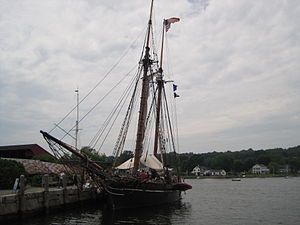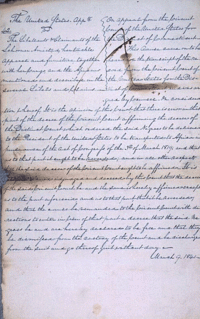Cross posted from The Stars Hollow Gazette
This is your morning Open Thread. Pour your favorite beverage and review the past and comment on the future.
Find the past “On This Day in History” here.
March 12 is the 71st day of the year (72nd in leap years) in the Gregorian calendar. There are 294 days remaining until the end of the year.
On this day in 1947, in a dramatic speech to a joint session of Congress, President Harry S. Truman asks for U.S. assistance for Greece and Turkey to forestall communist domination of the two nations. Historians have often cited Truman’s address, which came to be known as the Truman Doctrine, as the official declaration of the Cold War.
In February 1947, the British government informed the United States that it could no longer furnish the economic and military assistance it had been providing to Greece and Turkey since the end of World War II. The Truman administration believed that both nations were threatened by communism and it jumped at the chance to take a tough stance against the Soviet Union. In Greece, leftist forces had been battling the Greek royal government since the end of World War II. In Turkey, the Soviets were demanding some manner of control over the Dardanelles, territory from which Turkey was able to dominate the strategic waterway from the Black Sea to the Mediterranean.
Truman stated the Doctrine would be “the policy of the United States to support free peoples who are resisting attempted subjugation by armed minorities or by outside pressures.” Truman reasoned, because these “totalitarian regimes” coerced “free peoples,” they represented a threat to international peace and the national security of the United States. Truman made the plea amid the crisis of the Greek Civil War (1946-1949). He argued that if Greece and Turkey did not receive the aid that they urgently needed, they would inevitably fall to communism with grave consequences throughout the region.
The policy won the support of Republicans who controlled Congress and involved sending $400 million in American money, but no military forces, to the region. The effect was to end the Communist threat, and in 1952 both countries joined NATO, a military alliance that guaranteed their protection.
The Doctrine was informally extended to become the basis of American Cold War policy throughout Europe and around the world. It shifted American foreign policy toward the Soviet Union from détente (friendship) to, as George F. Kennan phrased it, a policy of containment of Soviet expansion. Historians often use its announcement to mark the starting date of the Cold War.
The Truman Doctrine underpinned American Cold War policy in Europe and around the world. The doctrine endured because it addressed a broader cultural insecurity regarding modern life in a globalized world. It dealt with Washington’s concern over communism’s domino effect, it enabled a media-sensitive presentation of the doctrine that won bipartisan support, and it mobilized American economic power to modernize and stabilize unstable regions without direct military intervention. It brought nation-building activities and modernization programs to the forefront of foreign policy.
The Truman Doctrine became a metaphor for emergency aid to keep a nation from communist influence. Truman used disease imagery not only to communicate a sense of impending disaster in the spread of communism but also to create a “rhetorical vision” of containing it by extending a protective shield around non-communist countries throughout the world. It echoed the “http://en.wikipedia.org/wiki/Quarantine_Speech quarantine the aggressor]” policy Franklin Delano Roosevelt sought to impose to contain German and Japanese expansion in 1937. The medical metaphor extended beyond the immediate aims of the Truman Doctrine in that the imagery combined with fire and flood imagery evocative of disaster provided the United States with an easy transition to direct military confrontation in later years with communist forces in Korea and Vietnam. By presenting ideological differences in life or death terms, Truman was able to garner support for this communism-containing policy.


 Welcome to the Health and Fitness weekly diary which is cross-posted from
Welcome to the Health and Fitness weekly diary which is cross-posted from 
 It’s a member of the brassica family, those nutrient-dense cabbages (as well as kales, brussels sprouts, broccoli and cauliflower) whose phytochemicals are highly regarded for their antioxidant properties. Kohlrabi is an excellent source of potassium and a good source of vitamin C and fiber, and it’s low in calories. The purple variety that some farmers grow also contains anthocyanins, another phytonutrient with antioxidant potential.
It’s a member of the brassica family, those nutrient-dense cabbages (as well as kales, brussels sprouts, broccoli and cauliflower) whose phytochemicals are highly regarded for their antioxidant properties. Kohlrabi is an excellent source of potassium and a good source of vitamin C and fiber, and it’s low in calories. The purple variety that some farmers grow also contains anthocyanins, another phytonutrient with antioxidant potential. On this day in 1959,
On this day in 1959,  On 1 March 1959, an unusual invitation to attend a theatrical performance at the Chinese military headquarters outside Lhasa was extended to the Dalai Lama. The Dalai Lama, at the time studying for his
On 1 March 1959, an unusual invitation to attend a theatrical performance at the Chinese military headquarters outside Lhasa was extended to the Dalai Lama. The Dalai Lama, at the time studying for his  On 12 March, protesters appeared in the streets of Lhasa declaring Tibet’s independence. Barricades went up on the streets of Lhasa, and Chinese and Tibetan rebel forces began to fortify positions within and around Lhasa in preparation for conflict. A petition of support for the armed rebels outside the city was taken up, and an appeal for assistance was made to the Indian consul. Chinese and Tibetan troops continued moving into position over the next several days, with Chinese artillery pieces being deployed within range of the Dalai Lama’s summer palace, the Norbulingka. On 15 March, preparations for the Dalai Lama’s evacuation from the city were set in motion, with Tibetan troops being employed to secure an escape route from Lhasa. On 17 March, two artillery shells landed near the Dalai Lama’s palace, triggering his flight into exile. On 19 March the Chinese started to shell the Norbulingka, prompting the full force of the Uprising. According to the freetibet website, on 21 March 800 shells rained down on the palace, including the shelling of the Norbulingka and Lhasa’s major monasteries, slaughtering thousands of Tibetan men, women and children. Combat lasted only about two days, with Tibetan rebel forces being badly outnumbered and poorly armed.
On 12 March, protesters appeared in the streets of Lhasa declaring Tibet’s independence. Barricades went up on the streets of Lhasa, and Chinese and Tibetan rebel forces began to fortify positions within and around Lhasa in preparation for conflict. A petition of support for the armed rebels outside the city was taken up, and an appeal for assistance was made to the Indian consul. Chinese and Tibetan troops continued moving into position over the next several days, with Chinese artillery pieces being deployed within range of the Dalai Lama’s summer palace, the Norbulingka. On 15 March, preparations for the Dalai Lama’s evacuation from the city were set in motion, with Tibetan troops being employed to secure an escape route from Lhasa. On 17 March, two artillery shells landed near the Dalai Lama’s palace, triggering his flight into exile. On 19 March the Chinese started to shell the Norbulingka, prompting the full force of the Uprising. According to the freetibet website, on 21 March 800 shells rained down on the palace, including the shelling of the Norbulingka and Lhasa’s major monasteries, slaughtering thousands of Tibetan men, women and children. Combat lasted only about two days, with Tibetan rebel forces being badly outnumbered and poorly armed. On this day in 1841,
On this day in 1841, 
 On this day in 1911,
On this day in 1911,  Following the
Following the  On this day in 1976, a group of 600 civil rights marchers are forcefully broken up in Selma, Alabama. This day would be remembered in the Civil Rights Movement as
On this day in 1976, a group of 600 civil rights marchers are forcefully broken up in Selma, Alabama. This day would be remembered in the Civil Rights Movement as  Bevel’s initial plan was to march to Montgomery to ask Governor
Bevel’s initial plan was to march to Montgomery to ask Governor